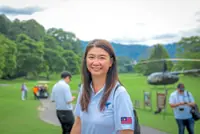Salmon farms are seen in a fjord near Leknes in the Lofoten Islands in 2018, within the Arctic Circle. Salmon farming is tailor-made in Norway, but not everything is perfect for this carnivore fish, which is being given an increasingly vegetarian diet. Stocks of small pelagic fish (anchovy, sprat, herring) used in fish food are limited, so aquaculture has turned to cheap vegetal sources to be able to produce more and more. — AFP
NORWAY’s fish farms are feeding their salmon an increasingly vegetarian diet in order to make their businesses more sustainable, but for these carnivorous pink-fleshed fish, all is not rosy.
In submerged cages at the Oksebasen fish farm, located at the crossing of two fjords in western Norway, the salmon are under constant watch on mobile underwater cameras.





